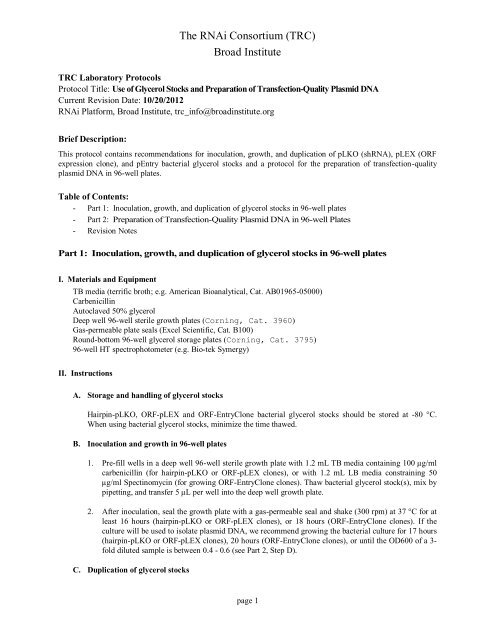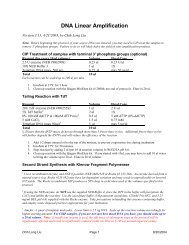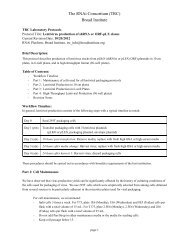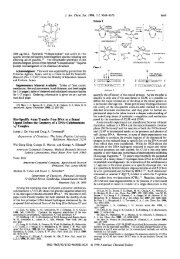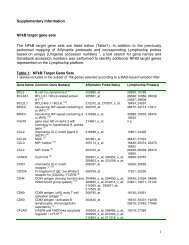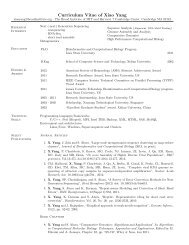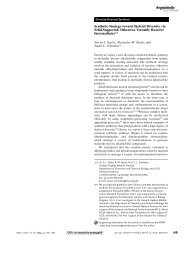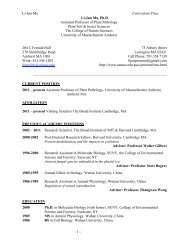The RNAi Consortium - Broad Institute
The RNAi Consortium - Broad Institute
The RNAi Consortium - Broad Institute
Create successful ePaper yourself
Turn your PDF publications into a flip-book with our unique Google optimized e-Paper software.
<strong>The</strong> <strong>RNAi</strong> <strong>Consortium</strong> (TRC)<br />
<strong>Broad</strong> <strong>Institute</strong><br />
TRC Laboratory Protocols<br />
Protocol Title: Use of Glycerol Stocks and Preparation of Transfection-Quality Plasmid DNA<br />
Current Revision Date: 10/20/2012<br />
<strong>RNAi</strong> Platform, <strong>Broad</strong> <strong>Institute</strong>, trc_info@broadinstitute.org<br />
Brief Description:<br />
This protocol contains recommendations for inoculation, growth, and duplication of pLKO (shRNA), pLEX (ORF<br />
expression clone), and pEntry bacterial glycerol stocks and a protocol for the preparation of transfection-quality<br />
plasmid DNA in 96-well plates.<br />
Table of Contents:<br />
- Part 1: Inoculation, growth, and duplication of glycerol stocks in 96-well plates<br />
- Part 2: Preparation of Transfection-Quality Plasmid DNA in 96-well Plates<br />
- Revision Notes<br />
Part 1: Inoculation, growth, and duplication of glycerol stocks in 96-well plates<br />
I. Materials and Equipment<br />
TB media (terrific broth; e.g. American Bioanalytical, Cat. AB01965-05000)<br />
Carbenicillin<br />
Autoclaved 50% glycerol<br />
Deep well 96-well sterile growth plates (Corning, Cat. 3960)<br />
Gas-permeable plate seals (Excel Scientific, Cat. B100)<br />
Round-bottom 96-well glycerol storage plates (Corning, Cat. 3795)<br />
96-well HT spectrophotometer (e.g. Bio-tek Symergy)<br />
II. Instructions<br />
A. Storage and handling of glycerol stocks<br />
Hairpin-pLKO, ORF-pLEX and ORF-EntryClone bacterial glycerol stocks should be stored at -80 °C.<br />
When using bacterial glycerol stocks, minimize the time thawed.<br />
B. Inoculation and growth in 96-well plates<br />
1. Pre-fill wells in a deep well 96-well sterile growth plate with 1.2 mL TB media containing 100 µg/ml<br />
carbenicillin (for hairpin-pLKO or ORF-pLEX clones), or with 1.2 mL LB media constraining 50<br />
µg/ml Spectinomycin (for growing ORF-EntryClone clones). Thaw bacterial glycerol stock(s), mix by<br />
pipetting, and transfer 5 µL per well into the deep well growth plate.<br />
2. After inoculation, seal the growth plate with a gas-permeable seal and shake (300 rpm) at 37 °C for at<br />
least 16 hours (hairpin-pLKO or ORF-pLEX clones), or 18 hours (ORF-EntryClone clones). If the<br />
culture will be used to isolate plasmid DNA, we recommend growing the bacterial culture for 17 hours<br />
(hairpin-pLKO or ORF-pLEX clones), 20 hours (ORF-EntryClone clones), or until the OD600 of a 3fold<br />
diluted sample is between 0.4 - 0.6 (see Part 2, Step D).<br />
C. Duplication of glycerol stocks<br />
page 1
<strong>The</strong> <strong>RNAi</strong> <strong>Consortium</strong> (TRC)<br />
<strong>Broad</strong> <strong>Institute</strong><br />
Pre-fill wells in round-bottom 96-well glycerol storage plates with 40 µL autoclaved 50% glycerol.<br />
Transfer 80 µL of culture from the 16 hour deep well growth plate into each destination plate to make<br />
replicate copies. Freeze immediately and store at -80 °C.<br />
Part 2: Preparation of Transfection-Quality Plasmid DNA in 96-well Plates<br />
I. Materials and Equipment<br />
Deep well 96-well non-sterile collection blocks (Marsh, Cat. DW9622)<br />
Clarification filter plates (Whatman, Cat. 7770-0062)<br />
pDNA binding plates (Whatman, Cat. 7700-2810)<br />
Plastic plate seals (Qiagen, Cat. 1018104)<br />
96-well DNA storage plates (Corning, Cat. 3790)<br />
Microseal films (BioRad, Cat. MSF1001)<br />
Buffers (see section A below, “Preparation of buffers”)<br />
Alkaline protease solution (500 units/ml, Promega, Cat. A1441)<br />
70 °C water bath<br />
Centrifuge (e.g. Jouan KR422, or Jouan CR4i)<br />
II. Instructions<br />
A. Preparation of buffers<br />
1. Resuspension Buffer: 50 mM Tris.HCl, 10 mM EDTA, pH 8.0.<br />
Resuspension Buffer with RNase A: Prior to use, add RNase A for a final concentration of 0.1 mg/ml.<br />
Store Resuspension Buffer with RNase A at 4 °C for up to 6 months (as per Qiagen Miniprep<br />
Handbook, Ed 2).<br />
2. Lysis Buffer: 200 mM NaOH, 1% SDS (w/v).<br />
3. Neutralization/Binding Buffer: 3.75 M Guanidinium Hydrochloride, 0.9 M KOAc, 1.4 M HOAc, pH 4.35.<br />
4. Wash Buffer: Prepare initial solution of 15 mM NaCl, 40 mM Tris.HCl, 25mM Tris, pH 6.65.<br />
To 120 ml of this solution, add 480 ml ethanol (100%) and mix well.<br />
5. Elution Buffer: 10 mM Tris.HCl, pH 8.0.<br />
Note: Buffers may be stored at room temperature for up to 6 months, unless otherwise indicated.<br />
B. Preparation of a fresh copy (V2) of bacterial glycerol stock(s):<br />
1. Follow instructions in Part 1 for inoculation and growth in 96-well plates and duplication of glycerol<br />
stocks to make a new glycerol copy (V2 glycerol). <strong>The</strong>se newly prepared V2s are then used in<br />
inoculations for plasmid DNA isolation.<br />
Note: Starting with a fresh glycerol copy can increase overall yield and decrease well-to-well variation in<br />
yield of transfection-quality DNA.<br />
C. Inoculation and growth of bacterial culture in deep well plates<br />
1. Follow instructions in Part 1 for inoculation and growth in 96-well plates, using the V2 glycerol copy<br />
to inoculate.<br />
page 2
<strong>The</strong> <strong>RNAi</strong> <strong>Consortium</strong> (TRC)<br />
<strong>Broad</strong> <strong>Institute</strong><br />
2. Grow the bacterial cultures on a plate shaker at 300 rpm, 37 °C for 17 hours, or until the OD600 of a<br />
3-fold diluted sample is between 0.4-0.6 (see step D).<br />
D. Measurement of cell density and harvesting cells<br />
1. Remove 40 µL of each bacterial culture and dilute with 80 µL fresh media. Measure the optical density<br />
of the diluted samples at 600nm (OD600). If the OD600 of the diluted samples are between 0.4 - 0.6,<br />
proceed with harvesting cells. If the OD600 measurements are less than 0.4 for a significant number of<br />
wells, continue to grow the bacterial cultures until the OD600 of 3-fold diluted samples are between<br />
0.4 - 0.6.<br />
2. Centrifuge the growth plate at 1,500 x g for 8 minutes at 4 °C.<br />
3. Remove the TB or LB media by inverting the growth plate. Gently tap the inverted plate against a<br />
paper towel to remove as much liquid as possible without disturbing the bacterial pellets.<br />
E. Purification of plasmid DNA (centrifugation method)<br />
1. Add 200 µL Resuspension Buffer with RNase A to each well of the growth plate, seal the plate, and<br />
vortex for several minutes until the bacterial pellets are fully resuspended.<br />
Note: in steps 1 - 6, seal the plate with a fresh plastic seal as indicated.<br />
2. Add 210 µL fresh Lysis Buffer to each well, seal, and gently tilt the plate back and forth a few times.<br />
Incubate at room temperature for exactly 4 minutes and proceed immediately to the next step.<br />
Note: This is a time sensitive step.<br />
3. Add 300µL Neutralization/Binding Buffer to each well, seal, and mix by tilting the plate back and<br />
forth a few times. Centrifuge at 3,000 x g for 30 minutes at 4 °C.<br />
4. Place a clarification filter plate on top of a deep well collection block. Use a multichannel pipette to<br />
transfer the clear liquid lysate from each well of the growth plate into the clarification filter plate as<br />
described below.<br />
Note: Try to avoid transferring cell debris from the bottom of the wells to the clarification filter plate,<br />
especially in the first transfer step.<br />
a. Transfer 500 µl lysate to the clarification filter plate by pipetting from the top of the well to obtain<br />
only clear liquid. Retain the remaining lysate at 4 °C.<br />
b. Centrifuge the stacked clarification filter and collection block at 3,000 x g for 5 minutes at 4 °C.<br />
c. Keep the clarification filter and collection block stacked together and transfer the remaining lysate<br />
(~175 μl, may contain some cell debris) to the clarification filter plate.<br />
d. Centrifuge again at 3,000 x g for 5 minutes at 4 °C. Discard the clarification filter plate and retain<br />
the collection block.<br />
5. Stack a pDNA binding plate on top of a clean collection block. Transfer the entire contents of the<br />
collection block from step 6 to the pDNA binding plate. Discard the used collection block.<br />
6. Centrifuge at 1,800 x g for 2 minutes at 4 °C. Discard the flow-through from the collection block.<br />
7. Place the pDNA binding plate back on the collection block. Add 600 µL Wash Buffer to each well of<br />
the pDNA binding plate. Centrifuge at 1,800 x g for 2 minutes at 4 °C. Discard the flow-through from<br />
the collection block.<br />
page 3
Version Notes:<br />
1/22/07<br />
4/1/09<br />
8. Repeat step 8 for a second wash.<br />
<strong>The</strong> <strong>RNAi</strong> <strong>Consortium</strong> (TRC)<br />
<strong>Broad</strong> <strong>Institute</strong><br />
9. Place the pDNA binding plate back on the collection block. Centrifuge at 1,800 x g for 5 minutes at 4<br />
°C to dry the pDNA binding plate.<br />
10. Place the pDNA binding plate on a clean DNA Storage Plate. Add 140 µL Elution Buffer to each well<br />
of the pDNA binding plate and incubate for 10 minutes at room temperature. Centrifuge at 1,800 x g<br />
for 5 minutes at 4 °C. Expected elution volume: 120-130 µL DNA per well.<br />
11. Seal the DNA Storage Plate with a Bio-Rad microseal film and store at -20 °C or -80 °C.<br />
Note: Use a plate seal that can withstand the storage conditions.<br />
1) Innoculation with fresh glycerol copy (V2) of hairpin-pLKO, ORF-pLX or ORF-EntryClone<br />
bacterial glycerol stock(s): Using a fresh bacterial glycerol stock to inoculate growth increases both<br />
overall yield and well-to-well yield consistency of pLKO.1 plasmid DNA.<br />
2) Alkaline Protease added to the lysis buffer: Adding Alkaline Protease to the Lysis Buffer improves the<br />
yield and quality of plasmid DNA. See http://www.promega.com/faq/wizsv.html for more information.<br />
3) Discontinued using Alkaline Protease in the lysis buffer: We experienced Alkaline Protease (AP) quality<br />
issues that caused significant DNA prep fails and consumed a great deal of time in troubleshooting. <strong>The</strong><br />
drawback of the inconsistent AP quality outweighed the advantages AP can offer.<br />
4) Discontinued 70 °C (30 minutes) incubation prior to binding DNA to the binding filter: We<br />
determined that this is an unnecessary step.<br />
page 4


